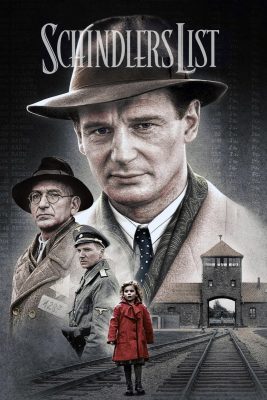
In the midst of World War II, Oskar Schindler, a German Nazi Party member, arrives in Nazi-occupied Kraków, hoping to capitalize on the war economy. He establishes an enamelware factory with the help of Jewish accountant Itzhak Stern, who uses his connections to finance the venture and employs Jewish workers, deemed essential to the war effort.
The Arrival of Amon Göth and The Kraków Ghetto Massacre
SS-Untersturmführer Amon Göth arrives in Kraków to oversee the construction of the Płaszów concentration camp. Upon its completion, he orders the liquidation of the Kraków Ghetto, resulting in a large-scale massacre. This horrific event, particularly the death of a young girl in a red coat, profoundly affects Schindler, leading to a crucial turning point in his motivations.
Schindler’s Transformation: From Profit-Seeker to Protector
Despite the atrocities, Schindler maintains his relationship with the Nazis, especially Göth, through bribes and charm. As Göth’s brutal reign continues, Schindler’s focus shifts from making a profit to saving as many lives as possible. He persuades Göth to let him establish a sub-camp at his factory, providing a protective shield for his workers.
The List: A Lifeline for 1,100 Jews
As the war begins to turn against the Germans, Göth receives orders to send the remaining Jews in Płaszów to Auschwitz. To prevent this, Schindler arranges to move his workers to a munitions factory he plans to build in Brünnlitz. He and Stern draft a list of 1,100 workers to be transferred, which comes to be known as “Schindler’s List.”
The Journey to Brünnlitz and Schindler’s Sacrifices
Due to a mistake, the female Jewish workers are redirected to Auschwitz-Birkenau. Schindler manages to secure their release through bribes. At the new factory, he prohibits SS guards from entering the production area and allows the Jews to observe the Sabbath. Over time, Schindler exhausts his fortune bribing Nazi officials and procuring useless shell casings, ensuring his factory produces no usable weapons.
The End of the War and Schindler’s Farewell
As the war ends in 1945, Schindler, a member of the Nazi party, must flee to avoid capture by the advancing Red Army. Despite orders to kill the Jewish workers, he convinces the SS guards to spare them. The workers present Schindler with a ring and a signed statement of his role in saving Jewish lives. Overwhelmed with emotion, Schindler breaks down, expressing his regret for not saving more lives before bidding his workers farewell.
Epilogue: The Legacy of Oskar Schindler
After the war, Göth is convicted of crimes against humanity and executed, while Schindler’s post-war life is marked by business failures and a troubled marriage. The surviving Schindlerjuden, along with the actors who portrayed them, pay homage at Schindler’s grave, placing stones and roses on his marker, honoring his memory and the lives he saved during one of history’s darkest periods.
Review
“Schindler’s List” is a 1993 American epic historical drama film directed by Steven Spielberg and starring Liam Neeson, Ben Kingsley, and Ralph Fiennes. The movie tells the true story of Oskar Schindler, a German businessman who saves the lives of over a thousand Jewish refugees during the Holocaust by employing them in his factories.
The film is a powerful and poignant exploration of one of the darkest periods in human history. Its uncompromising depiction of the horrors of the Holocaust, its complex characters, and its nuanced exploration of morality and humanity make it one of the most important films ever made.
The film’s visual style, from its stark black and white cinematography to its haunting imagery, is masterfully executed, creating a powerful and immersive cinematic experience. The use of handheld camera and long takes adds a sense of intimacy and urgency to the story, immersing the audience in the characters’ experiences.
The movie’s screenplay, written by Steven Zaillian, is a classic example of the three-act structure proposed by Syd Field. The first act introduces the characters and their situation, the second act involves Schindler’s efforts to save the lives of the Jewish refugees, and the third act features the tragic consequences of the Holocaust. This structure serves to keep the story focused and intense, as each act builds upon the previous one, leading to a powerful and emotional conclusion.
Schindler’s transformation from a selfish businessman to a hero who risks everything to save the lives of others is a central focus of the story. The film’s exploration of the complexity of human nature and the moral ambiguity of the characters is an example of complex and nuanced character development that adds emotional depth to the story.
The film’s score, composed by John Williams, is a standout element of the movie. The use of a haunting and melancholic melody, played on a solo violin, adds a layer of emotional depth to the story, elevating the film beyond a simple historical drama. The use of music as a storytelling device is a testament to the power of sound in cinema and a hallmark of Spielberg’s filmmaking style.